| Orbit Motorcycles
The company was founded by Mr.
Dorsett
in Sedgley Street, Wolverhampton. He was also involved with the Dorsett, Ford & Mee Engineering Company Limited,
which produced Diamond motorcycles.
The first 'Orbit' machine was
launched in 1913. It consisted of a clip-on engine that fitted
below the bottom bracket of a bicycle, driving the rear wheel
through a friction roller. Only a few were made. Production
ended during the First World War. The first post-war
model appeared in 1919. It was
powered by a 261.5 cc, two-stroke engine, of
the company's own design. It had a belt drive, and sold
for £50. The engine was supplied to other companies, including
Olympic Motorcycles in Green Lane, Wolverhampton. |
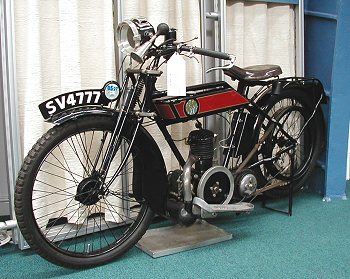 |
The 1921 Orbit machine that's in the
collection at the Black Country Living Museum, Dudley.
It is powered by a 261.5 cc Orbit engine. |
| The following is from an article that appeared
in the Motorcycle and Cycle Trader in June 1921.
The ‘Orbit’ Power Unit
Careful attention to detail
characterises the design of the two-stroke engine here described
On the occasion of a recent business
journey to the Midlands we visited the works of Orbit Motors, Ltd., of
Sedgley Street, Wolverhampton, and examined the various component parts
of the ‘Orbit’, 2½ hp. two-stroke, three-port, power unit there
produced. The complete engine is attractive in appearance, being, as is
obvious from the accompanying illustrations, well proportioned, while a
feature which at once strikes the observer is the ample area of the
cooling fins, especially on the cylinder head; this has an appreciable
effect on the efficiency of the unit, for overheating is unknown and a
minimum of plug trouble - an all too-common fault with two-stroke
engines is experienced.
The Large Port Area
The "Orbit" engine has generously
dimensioned ports, thus allowing the gases to gain ingress to and egress
from the cylinder with the utmost dispatch. An unusually large exhaust
pipe, 1½in. in diameter, is utilized, and this is so arranged as to be
free from sharp bends which might restrict the flow of the outgoing
burnt gases. For 1921 a new compression release valve
has been evolved; this delivers the released gases into the main exhaust
pipe through the medium of a steel tube, and thus no oily vapour is
thrown all over the rider's legs when the valve is operated.
Bore and stroke are 68 by 72 mm. (261.
5 c. c.), and the R.A.C. rating is 2.86 hp. Both cylinder and piston are
of close-grained grey iron, and are machined on up-to-date plant and
finally ground to fine limits. The material used acquires a perfect
surface after use and wears remarkably well. For the one-piece
crankshaft, the connecting rod and flywheel, high-grade steel forgings
are used. The reciprocating parts are carefully balanced, resulting in
an almost entire absence of vibration at all speeds. A split type
phosphor bronze big-end bearing has been adopted in order that any wear
at this point may be ‘taken up’ with a minimum of trouble. The
generously dimensioned main bearings are of ‘Richards’ plastic metal,
and these retain crankcase compression for a long period. In order to
enable the inlet port to be cleaned, the induction stump is readily
detachable.
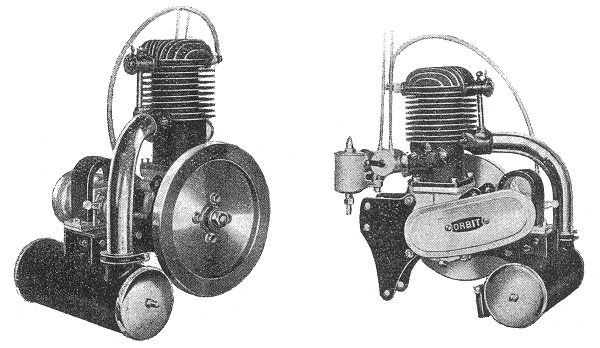
Both sides of the engine showing the
large area of the cooling fins, together
with the easy 'sweep' of the generously
proportioned exhaust pipe. |
Efficiency in Action
As one would expect after a careful
examination of the unit under discussion, it pulls remarkably well on
the road, and has quite a respectable turn of speed. Owing to the large
fins and ports the engine keeps cool even at the highest attainable
speeds, while an excellent feature is that it is not prone to
four-stroking. All the proprietary units, including carburettor,
magneto, and sparking plug, are of good quality, and the unit is
supplied as shown in the accompanying illustrations complete with engine
plates, silencer, magneto and carburettor, ready to drop into the frame.
Immediate deliveries in quantities can be given, and we understand that
the price is reasonable.
|
|
| A close-up view of the 261.5 cc engine
in the 1921 Orbit machine at the Black Country Living Museum. |
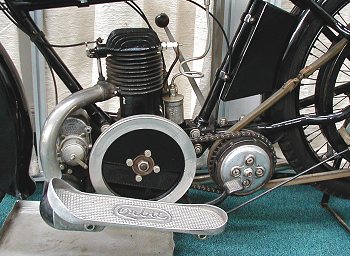 |
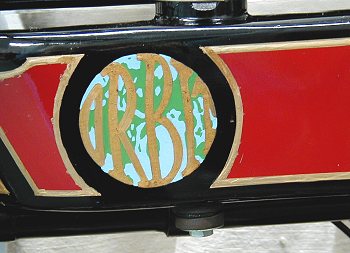 |
The logo on the side of the Orbit machine at the Black Country Living Museum, Dudley. |
| In 1921 the company launched three machines, the Model A, the
Model B, and the Model C, details are as follows: Model A, a
single speed machine with a belt drive.
Model B, two-speed Burman gearbox, and belt drive.
Model C, three-speed Burman gearbox, and belt drive.
The machines had a wedge-shaped petrol tank, painted black and
lined in gold. They used Swan forks, and a Middlemore's coil and
leaf sprung saddle. The magneto was either a 'baby' Fellows, or a an
M.L., and a Vici, or Cox-Atmos carburettor. Prices ranged from
£36.15s.0d. to £80 for a 3-speed combination with a Charles Hayward
sidecar. The machines sold well and so a stand was taken at the 1922
Olympia show, where four models were displayed; the S23, the BS23,
the OB23, and the BB23. The machines had a new frame with a
horizontal top tube, internal expanding drum brakes on both wheels,
a 3-speed Burman gearbox, and cast aluminium footboards. Details are
as follows:
S23, 261.5 cc engine.
BS23, 350 cc Barr & Stroud sleeve valve engine.
OB23, 350 cc Bradshaw oil-cooled engine.
BB23, 350 cc Blackurne engine.
Sadly sales fell in 1923 due to a trade depression, but hopes
were high, and the company took a stand at the Olympia show. Three
models were on display, two powered by Orbit's 261.5 cc engine, and
one with a Bradshaw oil-cooled engine. They had a three-speed Burman gearbox with chain drive. The oil-cooled machine sold for £60. |
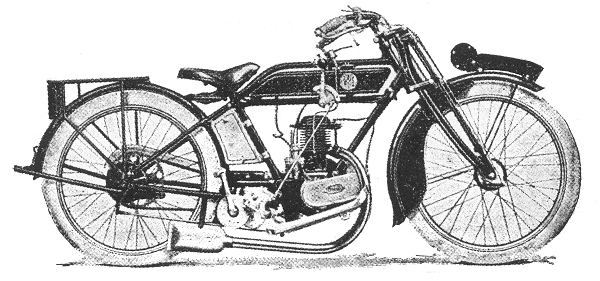
The 1923 two-stroke 'Orbit' from the Motor Cycle
magazine, 16th November, 1922.
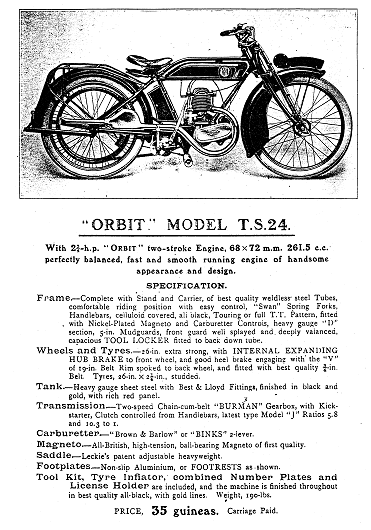 |
In 1924 there were three machines on offer, the T.S. 24, the O.B.
24, and the T.S. 12.
The T.S. 24 used the company's 261.5 cc engine, had a two-speed
Burman gearbox, and a chain and belt drive.
The O.B. 24 had a 349 cc Bradshaw engine, a six-speed Burman
gearbox, and a chain drive.
The T.S. 12 had the company's 261.5 cc engine, a twelve-speed
Philipson gearbox, with a primary belt drive, expanding pulleys on
the engine, a countershaft to give twelve speeds, and a chain final
drive. |
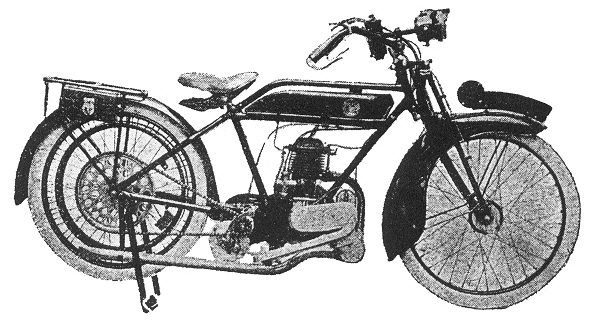
The 1924 T.S.12 'Orbit' with the twelve-speed 'Philipson'
gear.
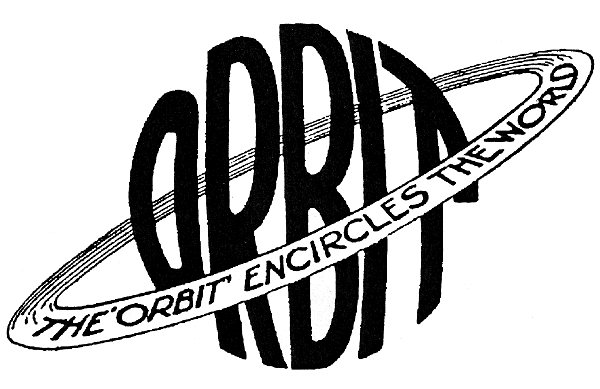
Sadly sales didn't improve. Early in 1924 production
ended, and what remained was sold to Mr. E. Morse, 65 Ranelagh Road, Wolverhampton, who continued to
supply engine spares. The factory was later used for the
manufacture of Diamond motorcycles.
|
| I would like to thank Ray Jones for his help in producing
this section. |
|